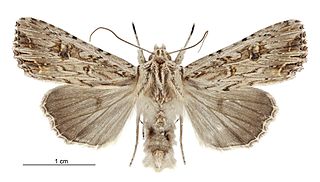
Ichneutica lignana is a moth of the family Noctuidae. It is endemic to New Zealand. This species is found on the Three Kings Islands as well as the North, South and Stewart Islands. This species lives in a variety of habitats including coastal areas, tussock grasslands, shrublands, and native forest, at a range of altitudes from sea level to over 1300 m. I. lignana is quite distinctive in appearance with its dark markings on the abdomen and forewings although it is possible to confuse Ichneutica morosa, Meterana pansicolor and Meterana pascoi with this species. Adults are on the wing throughout the year in the northern parts of the New Zealand but are restricted to the months of October to April in the more southern parts of the country.

Ichneutica semivittata is a moth of the family Noctuidae. It is endemic to New Zealand. It can be found from the Three King Islands down to Stewart Island. The similar species I. sulcana can be distinguished from I. semivittata as the former is much larger, has a darker hindwing and abdomen and has only one to three spots located behind the middle of the forewing in comparison to the 8 or 9 of I. semivittata. This species lives in a variety of habitats from open grasslands to clearings in forest and at a range of altitudes from the sea level to the alpine zone. Larval host species include Juncus procera, Carex secta as well as on tussock grasses such as Poa cita, P. colensoi and Festuca novae-zelandiae. Adults of this species are on the wing from August to April and are attracted to light.

Ichneutica lissoxyla is a moth of the family Noctuidae. It is endemic to New Zealand. It is found in the central and southern parts of the North Island and in most parts of the South Island. The species prefers snowgrass habitat in the alpine zone. I. lissoxyla is similar in appearance to I. paraxysta but can be distinguished as I. lissoxyla lack the black streaks on the forewings that can be found on the latter species and the male I. lissoxyla also has longer pectinations on antennae. The life history of this species is unknown as are the host species of its larvae. Adults are on the wing from January to April and are attracted to the light.

Ichneutica omoplaca is a moth of the family Noctuidae. It is endemic to New Zealand. It is widespread from the Bay of Plenty in the North Island down to Southland in the South Island. Specimens have also been collected from the Auckland Islands. It lives in a variety of habitats including beech forest clearings and tussock grasslands. This species has been recorded that some of the larval hosts of this species include Poa cita, Dactylis glomerata and it has been reared on Plantago lanceolata. The larva is undescribed but pupae have been found in a pine plantation in soil under weeds. Adults of this species are on the wing from October to March. The adult moths are variable in appearance but the diagnostic feature is the pale ochreous to white colouring between the basal streak and the costa which contrasts with the ground colour of the forewing.

Ichneutica petrograpta is a moth of the family Noctuidae. This species is endemic to New Zealand where it is found in the southwest districts of the South Island, including Westland, Otago Lakes and Fiordland. It is very similar in appearance to I. mutans. It inhabits tussock and shrubland in the alpine to subalpine zones. Adults of I. petrograpta are on the wing from December to February and are attracted to sugar traps. The life history of this species is unknown as are the host species of its larvae.

Ichneutica scutata is a moth of the family Noctuidae. It is endemic to New Zealand. This species can be found in the southern parts of the North Island as well as the eastern parts of the South Island. It is similar in appearance to I. insignis and I. skelloni but can be distinguished as I. scutata is much paler in appearance. It is likely this species inhabits lowland tussock grasslands as well as coastal dunes although it is not common in inland tussock grasslands. The larvae feed on a variety of herbaceous plants such as Plantago and Convolvulus species, Plagianthus divaricatus. It pupates on soil near its host plants. The adults are on the wing from late March to July.
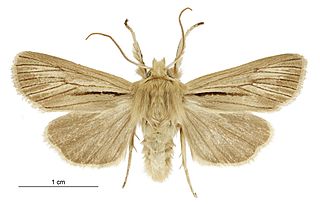
Ichneutica acontistis is a moth of the family Noctuidae. It is endemic to New Zealand and is found only in the South Island, mainly on the eastern side although not in the Nelson district. This species is similar in appearance to I. paraxysta,I. stulta and I. toroneura. I. acontistis is unlikely to be confused with I. paraxysta as the later is only found in the North Island. I. acontistis can be distinguished from I. stulta as the latter species has a strongly curved forewing edge where as I. acontistis' is straight. I. acontistis can be distinguished from I. toroneura as the former has a dark stroke of colour starting from the base of the forewing that I. toroneura lacks. I. acontistis inhabits tussock grasslands and the larvae of this species feed on species of grass found in the genera Poa, Elymus and Rytidosperma. It pupates under rocks and adults are on the wing from September to January. I. acontistis are attracted to light.

Ichneutica atristriga is a moth of the family Noctuidae. It is endemic to New Zealand and is found throughout the North, South and Stewart Islands. The larval hosts likely include tussock grasses included Poa cita, P. colensoi and Festuca novae-zelandiae. Larvae have been reared on species in the genera Bromus and Festuca. The adults of this species are on the wing from November to May. I. atristriga can possibly be confused with the smaller species I. propria. However I. atristriga has thorax and forewings that have a pinkish tinge and I. propria has a dark streak on the discal part of the forewing which I. atristriga lacks. A study has indicated that the population numbers of this species have decreased.
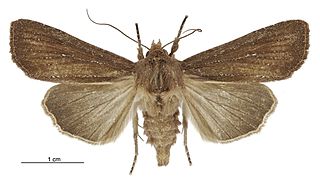
Ichneutica micrastra is a moth of the family Noctuidae. It is endemic to New Zealand. This species has been found only in the North Island and has been collected in the Northland, Auckland, Whanganui and Wellington regions. The preferred habitat of this species is wetlands and heathlands including gum fields in Northland. Adults of this species are on the wing from October to December. The life history of this species is unknown as are the host species of its larvae however it has been hypothesised that the likely larval host is a grass or grass like plant. This species is very similar in appearance to I. phaula and I. sapiens but can be distinguished as a result of differences in male antennae, the shape, colour and size of forewings, the range of the species as well as differences in genital shape.
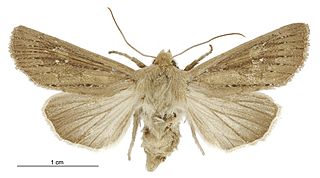
Ichneutica phaula is a moth of the family Noctuidae. It is endemic to New Zealand. It is found only in the South Island in the Nelson district, the eastern side of the South Island and Stewart Island. I. phaula inhabits tussock grasslands and coastal sand dunes. Host species include Ficinia spiralis, Ammophila arenaria, Poa cita and other "tussock grasses". The adults of this species are on the wing from October to December and are attracted to sugar traps. I. phaula is similar in appearance to both I. micastra, with whom it does not share a range, and I. sapiens which differs from I. phaula as I. sapiens is darker and has a more reddish tinge.

Ichneutica propria is a moth of the family Noctuidae. It is endemic to New Zealand. This species is only known from Tongariro National Park and Pureora Forest in the North Island but is widespread in the South Island. I. propria might be confused with faded I. atristriga, however the later species lacks the distinctive marking on the prothorax nor does it have the black mark running through the middle of the forewing. It is very common and widespread in montane to alpine grassland areas. Although the larvae have yet to be described, they have been reared on Poa cita and Festuca novae-zelandiae and are known to feed on introduced grass species. The adults of this species are on the wing from December to mid May and are attracted to light.

Ichneutica unica is a species of moth in the family Noctuidae. It is endemic to New Zealand and is found in the centre of the North Island and throughout the South Island. This moth is very similar in appearance to its close relatives Ichneutica phaula and Ichneutica toroneura. I. phaula can be distinguished as there is a difference in pectinations on the male antennae and I. toroneura can be distinguished as the black vein markings on the forewings is more uniform for that species in comparison to I. unica. I. unica is variable in appearance with the North Island specimens having a darker brown colour on the forewings and having a darker underside of the hindwings. This species inhabits open tussock grassland at various altitudes, coastal dunes, and inland volcanic dunes. Larvae feed on tussock grasses such as Chionochloa pallens and species in the genus Poa. Adult moths are on the wing from November to February and are attracted to both sugar and light traps.

Ichneutica steropastis, or the flax notcher moth, is a species of moth in the family Noctuidae. It is endemic to New Zealand and can be found throughout the country from the Three Kings Islands to Stewart Island as well as in the Chatham Islands. The larvae of this species feed on a variety of native and introduced plants however the New Zealand flax is one of the more well known host plants for the larvae of this moth. The larvae are nocturnal, hiding away in the base of the plants and coming out to feed at night. They create a distinctive notch in the leaf when they feed. The adults of this species are on the wing from October to March. Although adult specimens of I. steropastis are relatively easy to recognise they might possibly be confused with I. inscripta, I. theobroma or with darker forms of I. arotis. However I. steropastis can be distinguished as it has a long dark basal forewing streak that these three species lack.

Ichneutica paraxysta is a moth of the family Noctuidae. It is endemic to New Zealand. This species is very similar in appearance to its close relative I. acontistis but as the range of the two species do not overlap this is unlikely to cause confusion. I. paraxysta is only found in the North Island at the subalpine zones in the Mount Taranaki region and at Mount Ruapehu. It prefers tussock grassland and shrubland habitat. The life history of this species is unknown as are the host species of its larvae however it has been hypothesised that the larval host plants are species in the genera of Poa and Festuca.
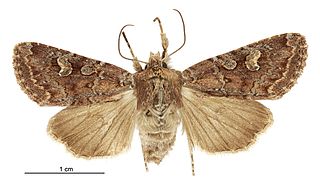
Ichneutica agorastis is a moth of the family Noctuidae. This species is endemic to New Zealand. This moth is similar in appearance to two other species in the genus but can be distinguished through the colour and size of its forewings. This species is found in the South Island and Stewart Island in open habitats in the subalpine zone. However, in Southland I. agorastis can be found down to sea-level. Adult moths are on the wing between January and April. The life history and host species are unknown.

Ichneutica ceraunias is a moth of the family Noctuidae. It is endemic to New Zealand. This species is found from the central North Island to the bottom of the South Island. Hosts of the larvae are species of Chionochloa and Festuca. This colourful moth is variable in appearance and can be mistaken for Ichneutica dione. Adults are on the wing from October to February.
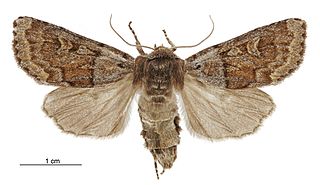
Ichneutica marmorata is a moth of the family Noctuidae. This species is endemic to New Zealand and can be found in the North Island at the Tongariro National Park and at Puketitiri near the Kaweka Range. In the South Island it is widespread. It prefers alpine to subalpine habitat but occurs down to sea level altitudes in more southern locations. Adults are on the wing from late October to February. Larvae of this species may use tussock grasses in the genus Chionochloa as their host and they have been reared on Festuca novae-zelandiae.

Ichneutica disjungens is a moth of the family Noctuidae. This species is endemic to New Zealand and can be found on the central volcanic plateau of the North Island and in the eastern as well as the south western parts of the South Island. I. disjungens inhabits tussock grasslands in the alpine and subalpine zones. The hosts of the larvae of this species include Poa cita, P. colensoi, and Festuca novae-zelandiae. The adults of this species are distinctive and are unlikely to be confused with other species. They are on the wing between October and March.
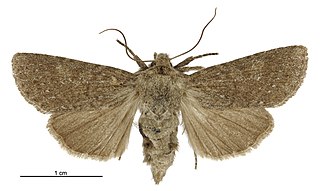
Ichneutica sollennis is a moth of the family Noctuidae. This species is endemic to New Zealand. This species is known from the eastern and central areas of the southern South Island. It inhabits alpine zones and has been collected in tussock grasslands. The life history of this species is unknown. Although the host species is currently unknown it has been hypothesised that this species have grass or grass like plants as host plants. Adults are on the wing from November to February and are attracted to light.
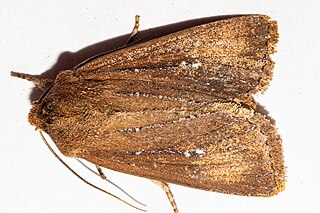
Ichneutica sapiens is a moth of the family Noctuidae. This species is endemic to New Zealand. I. sapiens is found in the central North Island, in the South Island in Westland and also the southern parts of the South Island, and in Stewart Island. This species inhabits wetland habitat but its life history is unknown as are the host species of its larvae. The adult moths are on the wing between December and early January and are attracted to sugar traps and to light. I. sapiens is very similar in appearance to I. micrastra but is a smaller moth with a shorter wingspan, has differently formed antennae and slightly different forewing markings.























